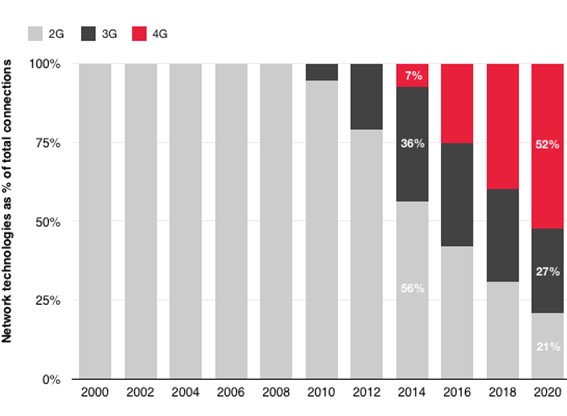According to the latest research report released by market research company GSMA Intelligence, the speed of popularization of 4G-LTE networks in China will be twice as fast as that of 3G networks. The company expects China's 4G connections to reach 100 million this year and will reach 900 million by 2020.
Considering the super-large scale of the Chinese market, the TD-LTE authorization issued recently to the three major operators is an important turning point in the development life cycle of TD-LTE. TD-LTE is not a competitor to the common FDD-LTE technology, but a useful complement to it. The entire 4G ecosystem will benefit from the introduction of these two technologies.
In December 2013, market leader China Mobile has taken the lead in launching 4G networks. It is reported that it has upgraded about 200,000 TD-SCDMA base stations to support the launch of TD-LTE networks. That is to say, its initial 4G website has covered all the important cities in the eastern coastal areas of China, benefiting 500 million people. By the end of 2014, the number of 4G base stations is expected to increase to 500,000. In addition, China Mobile is also preparing to launch more than 200 different 4G mobile phones this year, including a mobile phone with a price of 1,000 yuan and a series of 4G mobile phones of its own brand. Apple's iPhone series phones have also recently begun to sell to Chinese mobile users.

Similarly, China Telecom, the third-ranked operator in China, plans to launch entry-level 4G smartphones at the same price in the first half of the year, launching mid- to high-end smartphones before the end of the year. As of now, its number of 4G base stations has reached 60,000.
At the speed of such 4G network deployment, the two mobile operators are expected to obtain an initial 4G migration speed after Korea. By the end of this year, South Korea estimates that nearly 10% of 3G network connections will migrate to 4G networks. Relatively speaking, it took twice as long for China Mobile and China Telecom's 2G users (using GSM and CDMA2000 1x networks respectively) to migrate to 3G networks (TD-SCDMA and CDMA2000 EV-DO networks respectively). For example, China Mobile spent 14 quarters to migrate 10% of 2G networks to 3G networks. However, it may take half the time for the same percentage of users to migrate from a 3G network to a 4G network.
The 4G era of China Unicom may be relatively slow to start. As China's second largest operator, China Unicom confirmed in December 2013 that although it has obtained TD-LTE license (same as its competitors), it will still be committed to operating most of it through FDD-LTE technology. 4G network, and so far it has not been authorized by FDD-LTE technology.
It is important to point out that FDD and TDD LTE are actually two different styles of the same standard; it is not the same as the two technical standards of GSM/HSPA and CDMA for 2G and 3G hegemony. The emergence of the FDD-TDD dual-mode chipset helps mobile operators operate two different LTE networks, providing more options for attractive 4G handsets. Since the FDD-TDD dual-mode chipset eliminates the need to develop multiple chipsets and reduces costs, handset manufacturers may have economies of scale.
The FDD-TDD roaming feature (two-way roaming) is another advantage that mobile operators are committed to. A year ago, China Mobile cooperated with Korea KT, Clearwire and Hong Kong Mobile Branch to develop an international roaming function, which proved the interoperability of FDD-TDD LTE networks and created a unified LTE market. In 2012, the Multimode Multi-Frequency (MMMB) project under the Global TD-LTE Development Initiative defined the seven core LTE bands required for global smartphones, as well as an additional 4-7 roaming bands.
In the latest research report, GSMA Intelligence explained that although the global 4G network operates in more than a dozen different FDD/TDD bands, the mobile industry has made great strides in regional 4G band compatibility. As of January 2014, 17 TD-LTE mobile networks (and 11 TD-LTE fixed wireless networks) have been put into commercial use around the world; in the next few years, more than 40 mobile operators will be committed to launch TD. - LTE network.
As of the end of 2013, TD-LTE connectivity has accounted for 2.5% of global LTE connectivity; by 2020, this number is expected to grow to 25%. By that time, the global TD-LTE market will exceed the 500 million connection number, and more than one-quarter of the connections will come from China.
LED Linear Light is a kind of high-end flexible decorative lamp, advantages with low power consumption, long life, high brightness, easy to bend, maintenance free and so on.
It is especially suitable for indoor and outdoor entertainment places, building outline and billboard making.
According to different requirements, the product has 12V, 24V, 30CM,60CM, 90CM, 120CM and so on.Line lamps of different specifications can also be customized according to customer requirements.LED Linear Light
Linear Light,Linear Lamp,Led Linear Lighting,Linear Ceiling Light
Jilin Province Wanhe light Co.,Ltd , https://www.wanhelight.com